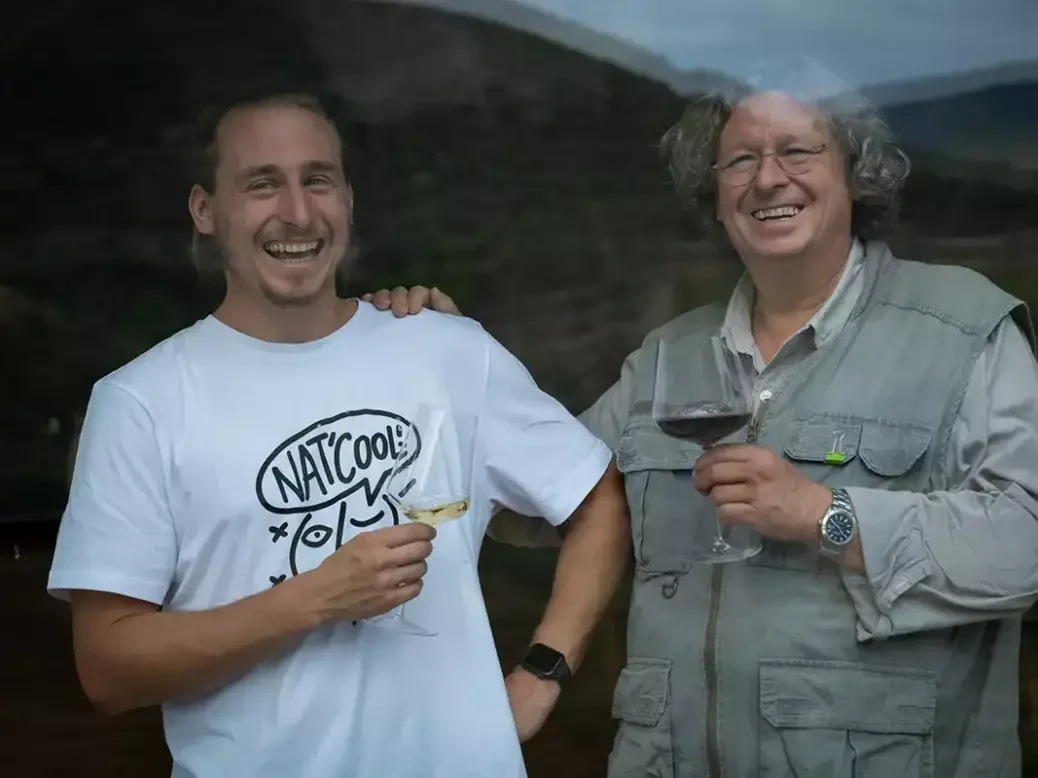
Sarah Ahmed gives a fascinating guided tour through the first three decades of the pioneering Douro winemaker Dirk Niepoort’s table-wine career.
Time and tide wait for no man, but in the world of wine, pendulum swings are in the gift of the maker. This extensive vertical tasting of Niepoort Redoma, Charme, and Batuta (from the first commercial release in 1991 to current releases) laid bare the challenges of pioneering “light” Douro winemaking (rather than Port winemaking) in a region on the edge of being too hot—not least when elegance, longevity, and finesse are the goal.
How bold (some would say crazy) it is to produce a wine in homage to Domaine de la Romanée-Conti La Tâche in such a climate. Inspired to replicate the wine that he found “so aromatic, so tannic, yet so expressively fine,” Niepoort Charme—a saignée from early-picked “green Port”—is Dirk Niepoort’s most daring, cerebral wine.
In the beginning
What encouraged this derring-do? It was not a given that Niepoort would join his family’s Port house, let alone make wine. The economics graduate fell head over heels with wine when he volunteered at fine-wine tastings during an internship at Mövenpick Wein, Zurich. Well, who wouldn’t? The first focused on Petrus, the second on Guigal. “I never wanted them [Mövenpick] to pay me, but at the end of year they gave me a bottle of wine I could never buy.”
The experience was addictive. Niepoort never studied winemaking but has never stopped studying wine. He is always keen to taste and talk wine; a friend’s daughter once described the avid collector as “the man with the cellar in his car.” While a passion for fine Burgundy, Bordeaux, and Mosel Riesling have informed Niepoort’s preference for freshness and lightness of being, he told me it was a bottle shared by a German importer that “changed my life.” Simply labeled vinho de consumo (Portuguese for the most basic table wine), it was made in 1938 by Niepoort’s grandfather Eduard Marius Niepoort to quench the thirst of workers but, decades later, remained so alive, still fresh.
Hot on the heels of his first vintage experience, which was at Cuvaison in Napa Valley, Niepoort returned to Portugal to work with his father in 1987. “My first wine is going to be a monster, but in 20 years I’ll be making fine wines,” he declared. In 1990, Niepoort duly produced Robustus, his first Douro red; following maturation in old Port pipes, it was bottled in April 1993. Poorly received by the Port wine trade and his father (who gave away all but one pipe), it was never released: “I barely showed it to anyone,” explains Niepoort. Robust, however, in his views (and with a succession of talented winemakers), he persevered because, he contends, “I don’t believe in failures. I believe failures are part of the process of getting better.”
A roller-coaster ride
Faithfully tracking vintage conditions—another part of Niepoort’s pioneering journey—the vertical tasting put the producer’s “no guts, no glory” approach under the microscope. Perhaps because Niepoort is not a trained enologist, he has never been afraid to think outside the box, and far from linear (indeed with the odd volte-face), this roller-coaster ride had its bumpy moments—more so than I had expected. But having tasted new vintages on release for some 20 years now, I know that Niepoort’s aspirations, at least, have always been clear. In his own words, “I want concentration but for it not to show in thickness, sweetness, or fatness; I want intensity.” None were blockbusters. These were tailored wines, but with a decade or more in bottle, the seams had not always held as well as hoped.
The most consistent of these flights—Redoma (Niepoort’s self-described “Douro ambassador”)—reinforced its exceptional value for money. Batuta, the most concentrated wine, has clearly benefited from earlier picking and less extraction in recent years. “The Batuta line was always more monster, more structure, more everything,” commented Niepoort’s son Daniel. He and his brother Marco challenged their father about its profile following a blind tasting of the 2011. Having both worked in the Mosel (they are their father’s sons), the pair now work for Niepoort. Charme has been fine-tuned with, as Niepoort puts it, a touch of “stinky reduction” and less new oak.
Attaining that natural balance that is born of the harmonious ripening of grape phenolics, sugars, and flavor is fiendishly hard in the Douro’s extreme climate. Heat spikes and hydric stress can shut vines down. While flavor and phenolic ripeness screech to a halt, sugars continue to climb, and acidity drops. Compared with Port wine, producers have had a relatively short time—a few decades rather than centuries—to identify those vineyards and varieties best suited to making Douro DOC wines, let alone honing winemaking skills. With no irrigation on hand to give succor to parched vines in times of drought, and steep terraces that must be picked laboriously by hand, the challenges are many and varied. Responding to them has involved rigorous site selection, with a consistent focus on increasingly elevated, well-adapted (to heat), old field-blend vineyards, for the most part, north-facing. In recent years, Niepoort’s growing roster of Douro vineyards (which now total around 70ha [175 acres]) have been cultivated biodynamically. While there is no recipe (picking can run into October), harvesting for red wines might now start as early as August, and there is invariably an element of early “acid-bank” picking at Niepoort.
Numerous winemaking tweaks—notably, extending whole-bunch ferments to Redoma, use of reductive winemaking, easing back on extraction, and a return to old, large-format oak—have all served to heighten freshness (or the perception of freshness). Does Niepoort ever kick himself for losing faith in the old Port pipes in which Robustus 1990 and his grandfather’s 1938 Vinho de Consumo matured? On the rare occasions I have tasted Robustus 1990, its finesse put me in mind of top-flight Hermitage from Chave. There and again, the maiden 1991 release of Redoma Tinto, aged in new French barriques, was also in fine fettle. Niepoort shrugs and smiles. He is honest to a fault—but above all, curious.
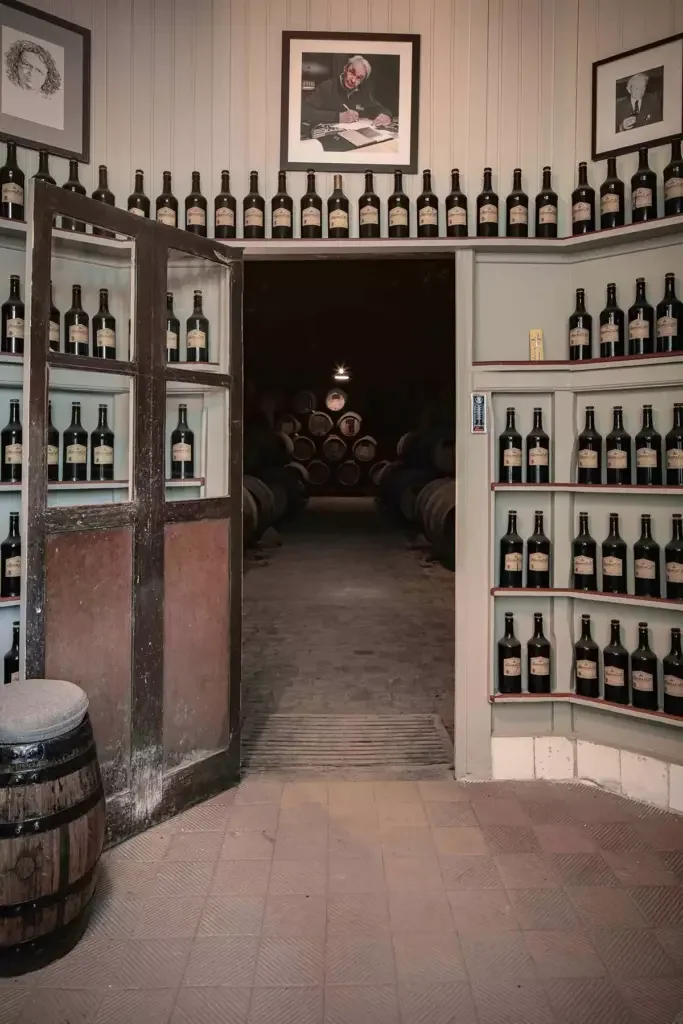
Triumph over adversity
Curiosity killed the cat, so the saying goes, but to reference Margaret Rand’s recent Niepoort profile (see WFW 78, pp.118–21), not Macavity. The latest vintages of Redoma, Charme, and Batuta artfully combine elegance with old-vine intensity. Tightly wound as they are, I suspect they will age well. As for Niepoort’s flagship single-vineyard releases, the hard yards of the past 20 to 30 years could not have borne better fruit. Built from the ground up—no reverse engineering here—Turris and Museu dos Lagares have a mesmerizing lightness of being. They are delicious reinforcement of Niepoort’s belief that “perfect wine is made of many imperfections.”
Tasting Niepoort table wines
This comprehensive free-pour tasting was hosted in Niepoort’s Serpa Pinto cellars in Vila Nova de Gaia, which is now home to the company’s “N Collectors” club. The wines—all from the Cima Corgo subregion—were tasted on November 24, 2022.
Redoma, Charme, and Batuta are made almost every year. For the most part, the gaps in recent years reflect the sales staff “wanting to sell, sell, sell,” sighed Niepoort. “Now we keep 240 bottles of everything whatever. But sometimes they forget,” he added ruefully.
NIEPOORT REDOMA TINTO
First made in 1991, Redoma Tinto was Niepoort’s original commercial Douro DOC release and is regarded as the “Douro ambassador”—that is to say, more rustic. Grapes from old, north-facing vineyards (more than 60 years old), ranging from 330ft to 1,650ft (100–500m) above sea level at Quinta de Nápoles and in the Pinhão Valley, form the backbone of Redoma. The main grape varieties are Tinta Amarela, Tinta Roriz and Touriga Franca.
Originally, all the grapes were destemmed. An element of whole-bunch ferment was introduced in 2009; the 2018 and 2019 vintages underwent 100 percent whole-bunch ferments. Since 2014, extraction has been reduced.
Most vintages of Redoma were aged in French oak barrels for about 18 months, typically with around 50 percent new oak. Old, large-format oak featured in 1996 and 2007, and a proportion was used from 2009. Between 2013 and 2017, Redoma underwent malolactic fermentation and was aged exclusively in old wooden vats. In 2018 and 2019, it was aged in old wooden barrels for around 22 months.
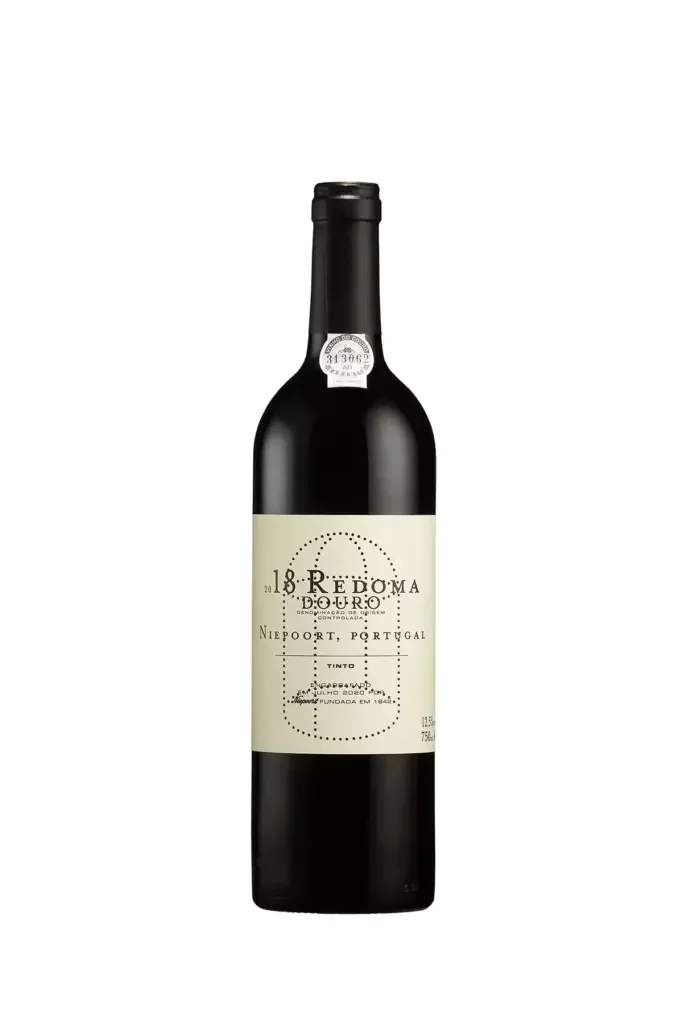
Niepoort Redoma Tinto 1991 (Douro DOC; 13.5% ABV)
From a hot year (declared for Vintage Port) with a dry summer. Cool autumn nights and light September rainfall helped the grapes complete the maturation cycle. Initially, this shows a touch of bouillon on the nose, but with a little air it opens up and holds well for hours, with no lack of vigor to its supple, plum-conserve palate, gamey undertones, and attractive cedar oak. Mellow tannins and balanced acidity make for an even, lingering delivery, with a clear sense of (warm-region) provenance to the lingering sweet fruit. Delicious. This maiden vintage aged in all-new French oak. What a debut. 94
Niepoort Redoma Tinto 1992 (Douro DOC; 13% ABV)
Favorable vintage conditions with cool September nights (a handful of shippers declared Vintage Port) have produced a lighter, fresher, “claret” style, with a green edge to the blackberry, currant fruit, cedar, and dusty graphite nuances. Less concentrated than the 1991, but it surely exceeds initial expectations. Because Niepoort did not like it on release, he sold it to a supermarket! 91
Niepoort Redoma Tinto 1994 (Douro DOC; 13.5% ABV)
A generally declared year renowned for its small crop of ripe, concentrated grapes. Salty bouillon to the nose and palate, with dried goji berry fruit. The acidity (firm) and tannins (extruded) outrun the fruit, resulting in a pinched finish. NS
Niepoort Redoma Tinto 1995 (Douro DOC; 13.5% ABV)
A warm summer and exceptionally hot August produced concentrated, ripe grapes. And so this tastes, with its dense core of cedar-licked, spicy, panforte di Siena dried fruit. Graphite and pencil-shavings notes lend a cool, complexing note. Balanced acidity carries the fruit. Tannic grip to the finish (assertive, not aggressive) gives an overall impression of sturdy intensity. 92
Niepoort Redoma Tinto 1996 (Douro DOC; 13.5% ABV)
From a relatively high-yielding, less tannic year, which favored Douro DOC over Port, this vintage is one of Niepoort’s own favorites. It was aged in large-format, old oak and concrete. Pinched at first, quite astringent, but with juice—a freshness—which “oils the wheels.” Unfurls, gaining in fruit and intensity, to reveal a spicy, black-fruited palate, with pronounced graphite, esteva (gum cistus), forest floor, and mushroom undertones. Retains energy and grip. 94
Niepoort Redoma Tinto 1997 (Douro DOC; 13.5% ABV)
The long, hot, dry summer produced rich, full-bodied, tannic wines (and was generally declared for Vintage Port). The 1997 puts me in mind of the 1991, with its sweet plum flesh and hints of bouillon. With elegant acidity and fine tannins, it is fluid and well-focused, with graphite and lead-shot undertones to the persistent finish. Accomplished. 94
Niepoort Redoma Tinto 1999 (Douro DOC; 14% ABV)
A typically hot summer; regarded as a good year. Vegetal and soupy, this bottle seemed overdeveloped. Past it. NS
Niepoort Redoma Tinto 2000 (Douro DOC; 13.5% ABV)
A low-yielding vintage of concentrated, ripe grapes “with a lot of skin and little juice”; generally declared for Vintage Port. As if to reflect its contemporary rebadging, the 2000 Redoma retains animated plum fruit, with inky, floral, esteva lift and spice. Surprisingly primary still, though hints of lead shot and meat-pan juices lend savory, tertiary interest. Gently ruffled graphite tannins and balanced acidity make for a very complete, accessible wine, if not the most vigorous or structured. 93
Niepoort Redoma Tinto 2001 (Douro DOC; 13.5% ABV)
A milder, late year has produced a well-structured Redoma vintage, with firm, chalky, spicy tannins, fresh acidity, and persistent, well-defined, energetic, black and red fruits that continue to build. Arresting intensity, line, and length, with signature Redoma/Douro, spicy, esteva lift to the tail. 95
Niepoort Redoma Tinto 2002 (Douro DOC; 13% ABV)
Wet conditions during harvest made for a difficult year. The 2002 is a little muddy on the nose, with green vegetal notes and a lighter, leaner palate, with astringent tannins. Beginning to dry out. NS
Niepoort Redoma Tinto 2003 (Douro DOC; 13.5% ABV)
From a dry, hot year that was generally declared for Vintage Port, the 2003 has a Port-like profile, with brusque, spicy tannins, oyster-shell salinity, and predominating black-olive and prune fruit. Brighter red fruits leaven and bring some juice. Robust, with an occluded, warm finish. 87
Niepoort Redoma Tinto 2004 (Douro DOC; 14% ABV)
From a very hot, dry year that produced some impressive reds. This bottle out of condition. NS
Niepoort Redoma Tinto 2006 (Douro DOC; 14% ABV)
Unseasonably high temperatures in the last week of August and the first two weeks of September brought the harvest forward. Relatively developed, missing some energy and structure, and yet highly flavorsome, with a savory, slightly bloody palate, showing prunes, tapenade, sage, chocolate, cedar, and warm stones. Ruffled, dusty tannins layer into the finish. Drink over the next year or two. 87
Niepoort Redoma Tinto 2007 (Douro DOC; 13.5% ABV)
A balanced, low-yielding, generally declared year produced uncommonly elegant Vintage Ports. Redoma is elegant, too, doubtless also influenced by a shift from aging in 100 percent French oak barriques, to aging 40 percent in 2,000-liter oak vats. Enticing, inky, slightly wild, floral notes and leather to the nose—attractive Brettanomyces—follow through in the mouth and are well integrated, indeed subsumed, by the vibrant red, black, and blue fruits of the forest. With a touch of grip to the finish, this has yet to hit peak drinking. 94
Niepoort Redoma Tinto 2008 (Douro DOC; 13.5% ABV)
Milder conditions and low yields have produced a well-structured wine, with black-olive, cooler fresh blackcurrant, and lead-pencil notes. Tight-knit, it has yet to shrug off the cloak of fine but plentiful iodine-tinged, slightly vegetal tannins (or is it just in a sulky phase?). This vintage saw a return to 100 percent barrique-aging. Keep. 91+
Niepoort Redoma Tinto 2009 (Douro DOC; 14% ABV)
An August temperature spike accelerated the ripening process and produced rich, ripe wines. Distinctly savory, with leather, garrigue/dried herbs, cedar-oak, and warm-stone layers to the black olive and blue fruits. Burly tannins bring frame and grip to the finish. Dense and satisfying, it aged in a combination of barriques and 2,000-liter, old wooden vats, the latter becoming the exclusive vessel for aging from 2013. 92
Niepoort Redoma Tinto 2010 (Douro DOC; 13.5% ABV)
A higher-yielding vintage. Light rain in early September provided respite for the vines during a very hot and dry maturation period. A lighter-bodied year, a touch wild, with pronounced lavender to the black-olive and black-berry fruit. Lightly mouth-coating tannins entangle the juicy fruit, detracting from the finish and flow. 87
Niepoort Redoma Tinto 2011 (Douro DOC; 13.5% ABV)
A much-acclaimed vintage produced statuesque Vintage Ports (a general declaration) and impressively concentrated, structured Douro reds. The elegance of this wine is quite remarkable given the year. Soaring florals and ultra-fine chalky tannins bring a floating sensation—sublime lift—to the dark-berry, currant, and black-olive fruit. Elegant, very persistent, with intense but not dense fruit, which, in 2011, was sourced from old vines near Quinta de Nápoles and vinified with 30 percent stalks. The resulting wine was aged for 12 months in used French oak barrels, then for another 15 months in large-capacity wooden vats. Exceptional and exceptionally elegant for 2011. Snap it up if you can find it! 97
Niepoort Redoma Tinto 2013 (Douro DOC; 13.5% ABV)
The 2013 harvest began earlier than usual on August 19, to maintain high acidity and avoid high alcohol. Job well done. Lovely intensity and flow of violet-scented pomegranate and red, black, and blue fruits of the forest. Fresh, delicate, yet very persistent, with a light pick of tannins, a hint of cedar, and a long, cool, graphite finish. A more translucent, pared-back Redoma, with the structure and intensity to age. Ultra-refined, unlike previous Redomas, it underwent the malolactic fermentation and aged exclusively in large, old wooden vats. 95
Niepoort Redoma Tinto 2014 (Douro DOC; 12.5% ABV)
An early September start to the vintage avoided rain that beset most later that month. Shares the elegant floral lift and ephemeral gossamer fruit of the 2013 but, with a vegetal note, lacks the intensity and structure. Fine-grained tannins are seamlessly integrated. 92+
Niepoort Redoma Tinto 2018 (Douro DOC; 12.5% ABV)
Perfumed with violet, lavender, and peony notes to the intense but sylphlike blueberry fruit and sweet raspberry, this vintage was fermented with 100 percent whole bunches. Fine tannins and fresh acidity; lively, long, fluid finish. Very much at the delicate end of the spectrum for the Douro but with greater intensity of fruit than the 2014. Graceful. 94
Niepoort Redoma Tinto 2019 (Douro DOC; 12% ABV)
With mild days and cool nights in August, harvesting began on August 8, peaked during the week of September 8–15, and concluded on October 1, which perhaps accounts for the fascinating sensation of a “riper” flavor spectrum when compared with the 2018, despite a touch less alcohol—at 12%, the lowest yet. Reveals exotic lily, damask-rose florals, sweet raspberry, blueberry, and a hint of kirsch to the expressive nose and palate. Yet the 2019 retains a weightless quality. Ripe but present chamois tannins and persistent acidity lend carry to the finish. This vintage was aged in old wooden barrels. Perplexing but intensely pleasurable. 95
NIEPOORT CHARME
Following a trial in 2000, Charme was first released in 2002. It is sourced from small, shaded, very old, field-blend vineyards at 1,150ft (350m) above sea level in Vale de Mendiz, on the banks of the Pinhão River. Lead grape varieties include Tinta Roriz, Touriga Franca, and Rufete.
Grapes are harvested early and foot-trodden in traditional stone lagares with 100 percent whole bunches. As soon as the ferment starts, a portion of fermenting grape must is bled off (saignée) to complete fermentation in French oak barrels. (The balance, which undergoes further foot treading, is destined for Port.)
Charme was originally fermented and aged in 100 percent new French oak (François Frères) barriques. Since 2010, the amount of new oak has decreased and today stands at around 10 percent; the barrel size has increased to 500 liters.
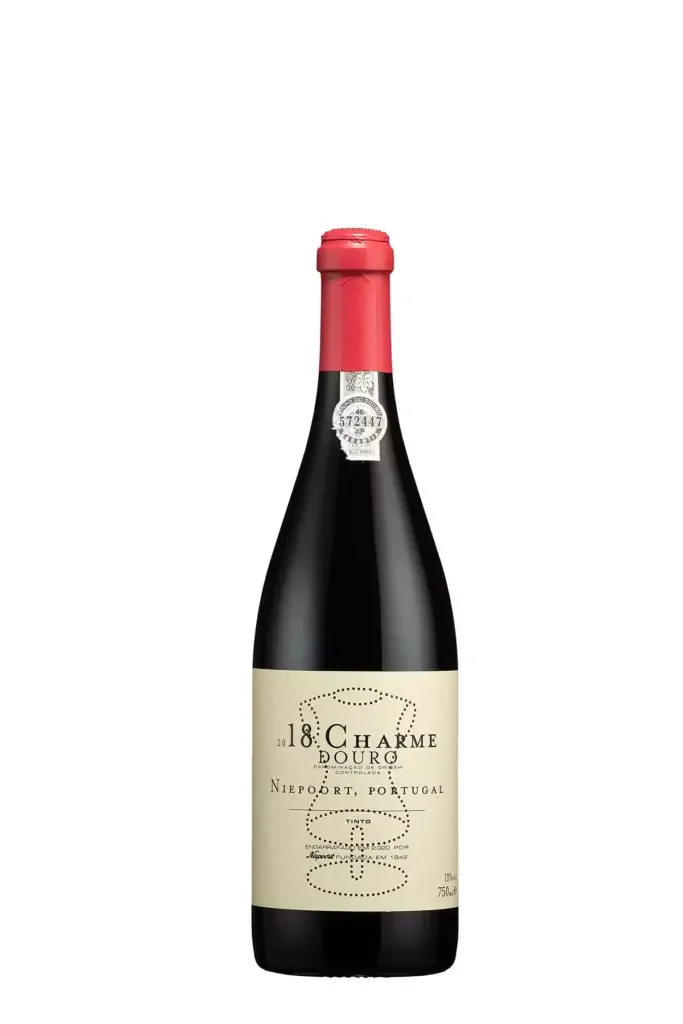
Niepoort Charme 2000 (Douro DOC; 14% ABV)
Despite the stated goal of elegance, this trial vintage is a generous wine. Referring to this and its cloak of oak, Niepoort described this release as “quite disgusting.” Much as it is big and woody, it does have juice. A redeeming factor. 85
Niepoort Charme 2002 (Douro DOC; 13% ABV)
From 2002—“a good year only to sell umbrellas,” quipped my Portuguese fellow taster—this has a degree less alcohol and an attractive austerity, a relative dryness, about it, compared with the 2000, with bony tannins and firm acidity. It is dark-fruited and savory, with flashes of green, mushroom, and spicy undertones. The Douro meets Burgundy. 92
Niepoort Charme 2004 (Douro DOC; 13.5% ABV)
Attractive, ripe Pinotesque, cherry-chocolate truffle, with savory, salty, tertiary undertones. Something attenuated, wing-clipping, about the delivery is at odds with the fruit generosity. An uneasy fit for the frame? Or vice versa? 90
Niepoort Charme 2006 (Douro DOC; 14% ABV)
In the line of 2002, this has an austerity about it, with bony tannins and a firm, spicy, red-fruited palate. A tad lean. 87
Niepoort Charme 2007 (Douro DOC; 13.5% ABV)
From a milder year, the 2007 is pale red, with enticing peony, mint, and tobacco aromatic detail to the red fruit and smoothly textured, vegetal tannins. Well focused, with a saline edge and mushroom undertones going through. Finishes on the austere side. 93
Niepoort Charme 2008 (Douro DOC; 13.5% ABV)
Dark-fruited, spicy, and supple through the mid-palate, with savory mushroom and lead-shot nuances. Graduating, fine-grained, smudgy graphite tannins make for a tapering, intense finish. 93
Niepoort Charme 2009 (Douro DOC; 14% ABV)
From a warm year, this smells and tastes quite Porty, with a bottle-sick character. Evolved. NS
Niepoort Charme 2010 (Douro DOC; 13% ABV)
Distinctly tertiary, with a smooth, sweet, and savory palate—all game and leather, with chocolaty tannins. Misses the fruit intensity to balance. 85
Niepoort Charme 2011 (Douro DOC; 14% ABV)
The vigor of the vintage shines through. The 2011 is firmer, better delineated than the 2009, and more concentrated than the 2010. Toasty, structuring oak leans into the ripe blue, red, and black-berry, and plum fruit, making its mark on the cedar-licked, spicy finish. Good tension and drive. 92+
Niepoort Charme 2012 (Douro DOC; 14% ABV)
An about-face? Much greater purity and refinement, even taking into account that it was a year of balanced maturation. Lighter-bodied, more lifted, with vibrant red fruits, pithy tannins, delicate cedar, and complexing, savory, spicy undertones. The whole harmoniously delivered, very complete. Lovely. 94
Niepoort Charme 2013 (Douro DOC; 13% ABV)
Ripe and soupy, with low acidity. Out of condition, seemingly… NS
Niepoort Charme 2014 (Douro DOC; 13% ABV)
Much livelier than the 2013 vintage. Perky, chalky, acidity, and graphite tannins extend and frame the fresh, with violet-inflected blackcurrant fruit. Graphite and tertiary, meaty, vegetal undertones just starting to develop. 92+
Niepoort Charme 2016 (Douro DOC; 13% ABV)
A low-yielding vintage. A dry, hot summer and September rains interrupted the maturation process delaying vintage, but some blocks were harvested earlier for balance. At the lighter end of the color spectrum and in palate weight, with emphatically red-berry, cherry fruit, crunchy pomegranate, and herb-inflected Campari. A softer vegetal underlay—velvetiness—makes for a suave mouthfeel. Nice whole-bunch detail and lift. 93
Niepoort Charme 2017 (Douro DOC; 13.5% ABV)
A very warm year; the harvesting for Charme started early on August 24. The 2017 has damp-earth inflections to the nose and palate. The technical fiche refers to the “subtle aroma of old barriques providing a superb rustic character,” so perhaps that is the explanation. Anyway, the fruit is expressive in the mouth, slaking the palate with vivid red berry and blackcurrant fruit. Fine, pithy tannins and crunchy acidity add to the energetic impression. Lovely precision to the finish. But for a reservation about the damp earth, I would have scored it even higher. 93+
Niepoort Charme 2018 (Douro DOC; 13% ABV)
A livewire. Crunchy, spiraling acidity spears the ripe but fresh, delicate raspberry palate. And it’s a long, precise spear throw. Lightly pithy tannins maintain line and subtly anchor the fruit, which builds in intensity. Fleet of foot and, for now, intensely pure and primary, it will be interesting to see how this wine develops in bottle. Great aging potential. 95+
Niepoort Charme 2019 (Douro DOC; 13% ABV)
A sappy, rather high-toned nose, with blackberry and apple pie, pithier red fruits, and white chocolate. A little disjointed; the elements are still coming together. One to review. NS
Niepoort Charme 2020 (Douro DOC; 13.5% ABV)
Three July heatwaves reduced yields somewhat. Emphatically red-fruited but broader than the 2018 and 2019, with smooth, ripe berry and cherry fruit, nutty croquante, and a lick of white chocolate. Pithy chamois tannins and balanced acidity make for a pliant structure. 92+
NIEPOORT BATUTA
Batuta (meaning the baton used by an orchestra conductor) was first released in 1999. The backbone was originally lower vineyards (330–660ft [100–200m]), notably Quinta do Carril. Since 2003, grapes have been sourced from a south-facing vineyard near Quinta de Nápoles, located at an altitude of 1,150 to 2,450ft (350–750m), with vines more than 100 years old, to bolster natural acidity.
Since 2010, the new oak has been progressively reduced to around 25 percent. Extractions are gentler and the wine spends longer macerating (infusing) on skins.
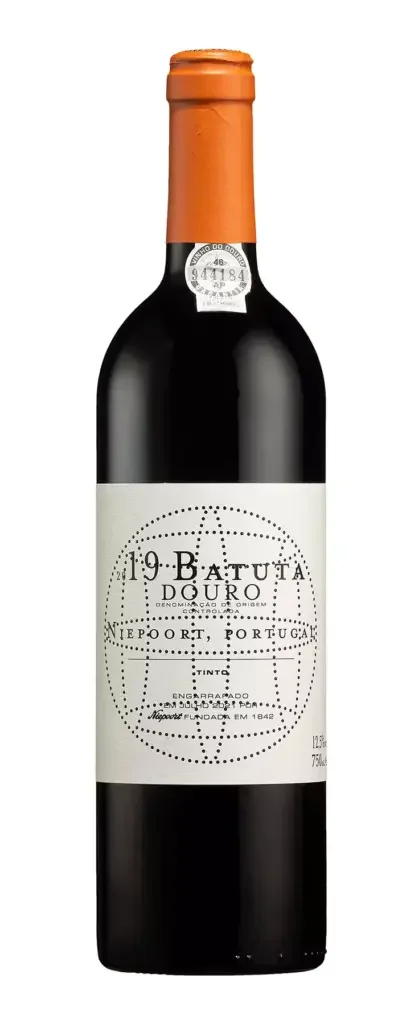
Niepoort Batuta 1999 (Douro DOC; 14.5% ABV)
Mature, rich, and ripe—perhaps a touch soupy and overripe. Still with concentrated blackcurrant and chocolate and cedar oak. The tannins are broad and pulpy now. Holding, though. 87
Niepoort Batuta 2000 (Douro DOC; 14% ABV)
Riper still than the 1999, broad and dense, with some raisined fruit and savory roast chestnut to the finish. Ample. 86
Niepoort Batuta 2001 (Douro DOC; 12.8% ABV)
With its cedar-scented, dark-currant, berry fruit, and tighter knit palate, this is a standout Batuta, with more than a touch of Bordeaux in terms of structure and finesse. Lovely freshness, line, and length, with a charge of fine, silty, tending-to-savory tannins. The palate—all dark fruits—is controlled and well defined. Beautifully balanced, it is a triumph in a “ducks-in-a-row,” milder year when, it would seem, flavor, phenolic, and sugar ripeness walked hand in hand to ripeness. 95
Niepoort Batuta 2003 (Douro DOC; 13.5% ABV)
Burly, a little baggy and overripe, with prune and raisined fruit. Ripe but present tannins buttress the dense, fruitcake flavors. With its profile and warm, generous finish, this will appeal to Port lovers. Bring a knife and fork! 87
Niepoort Batuta 2004 (Douro DOC; 14% ABV)
Well concentrated, with structure and flow—orchestrated fruit—as befits a wine labeled “conductor’s baton.” There is depth and flesh to the plum and blueberry fruit, which is gently segueing into tertiary expression, with attractive hints of dried olive and raisins. Delicious detail, too, with saltbush, silverside, and graphite layers. Ripe but fine tannins and harmonious acidity make for a long, lingering finish. 94
Niepoort Batuta 2005 (Douro DOC; 14% ABV)
A dry and hot year; a light rain shower in early September allowed the fruit to complete maturation while maintaining acidity. Rich, ripe, and toasty, with great intensity to the dry, salt-cured, black and dark-vine fruits, and a complexing, sweet nutty earthiness like presunto—Ibérico pork—from Alentejo’s acorn-fed black pigs. Abundant, grainy, ripe tannins and balanced acidity underpin the concentrated palate. Bold—a feast in a glass. 92+
Niepoort Batuta 2007 (Douro DOC; 14% ABV)
Like Redoma Tinto in this vintage, the nose and palate shows the telltale signs of Brettanomyces, with bloody, inky, earthy nuances—here more pronounced, though Batuta is more concentrated. There is no shortage of attractive, ripe, but controlled black and blue fruits, with salty dry-cured olive fruit to distract, but (at least for my taste) the Brettanomyces detracts from length and finesse. 88
Niepoort Batuta 2010 (Douro DOC; 13% ABV)
Reflecting a less concentrated vintage, the 2010 has enjoyable freshness and juiciness to its black- and blue-berry fruit, which, with its fine-grained tannins, makes for a certain elegance. Pleasant, if not the charisma and complexity of top years. 88
Niepoort Batuta 2011 (Douro DOC; 14% ABV)
If the 2010 lacked charisma, the 2011 is Batuta on steroids, with its muscular buttress of rich, ripe, but present tannins. No shortage of oomph in this celebrated vintage. Indeed, some warmth, a generosity of spirit. It reveals concentrated black and blue fruit, with salty, cured black-olive fruit and lashings of cedar oak. An opulent expression for Niepoort. An impressive, if demanding drink. 93+
Niepoort Batuta 2012 (Douro DOC; 13.5% ABV)
Though there is fruit weight and some warmth to the finish, a cooler maturation period and seemingly less extraction has resulted in a lighter, fresher Batuta. It is a touch high-toned, with a balsamic edge to the blue- and black-berry fruit and incipient cured black olive. Cedar-spiced, the tannins are ripe but feathery, less imposing in a positive way, which allows the fruit and freshness to express itself. 92
Niepoort Batuta 2014 (Douro DOC; 12.5% ABV)
Like the 2012, ruffled, gently textural tannins make for an enjoyable delivery of rich, ripe, red-cherry fruit with a kirsch-like ripeness but no warmth in the tail. Fresh (as distinct from cured) black olive, a kiss of truffle, and chocolate/cedar oak flatter the fruit. A quite different expression—spatial, less dense—with markedly lower alcohol. 92+
Niepoort Batuta 2015 (Douro DOC; 12.5% ABV)
Quite tight-knit for 2015, with elegantly structuring, seamless tannins, and a succulence to the red, black, and blue fruits. Nice detail, too, with floral and dried-herb lift, salty, cured, black-olive intensity, and a sanguine undertow. Though weighing in at just 12.5%, there is a sense of warmth to the finish (or is it an association with its Mediterranean flavors?). 93
Niepoort Batuta 2019 (Douro DOC; 12.5% ABV)
A yin-and-yang nose, with high-tone lift and an earthy bass note. In the mouth, fresh black and blue fruits mingle with a delicate warp and weft of violets, bitter chocolate, crushed coriander seed, and fresh pencil shavings (aromatized cedar and graphite). The profile is decidedly drier—more restrained—than its predecessors. The structure are more refined, with elegant, sluicing acidity, and ultra-
fine tannins. 95+
NIEPOORT SINGLE-VINEYARD RELEASES
First released in 2012, Turris (meaning tower) hails from a south-facing 0.8ha (2-acre) vineyard at nearly 1,500ft (450m) in Covas do Douro. The field-blend vines are more than 130 years old. It is fermented with around 20 percent whole bunches and aged in old foudres.
First released in 2018, Museu dos Lagares is sourced from a 60+ year-old, 1.8ha (4.4-acre) field-blend vineyard at 850ft (260m) above sea level in the Vale de Mendiz, on the banks of the Pinhão River. It was acquired by Niepoort from Sandeman in 2003 and originally contributed to Charme. Like Charme, it is barrel-fermented and aged in French oak barrels after a short period of foot-treading in lagar. It aged for 28 months in barrel.
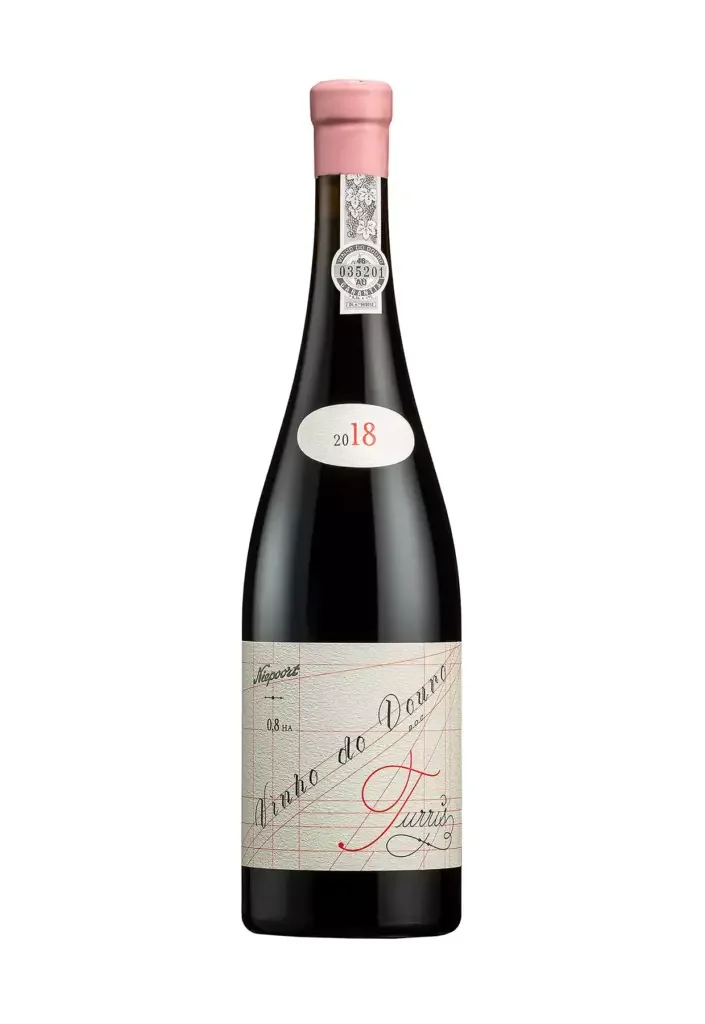
Niepoort Turris 2017 (Douro DOC; 13% ABV)
The blurt of fresh raspberries to the nose is tempered by a touch of earthy reduction, which swiftly disappears on the palate. Violets, lily, and coltsfoot notes add sensual lift to the ripe but succulent, sweet, raspberry and blueberry fruit. Sappy acidity and suave, “wet” tannins are as fluid as the fruit they carry on a finely honed persistent finish with attractive vegetal and earth nuances. 95+
Niepoort Turris 2018 (Douro DOC; 12.5% ABV)
With its blue and black fruits, the fruit spectrum is darker than the 2017, but it could not be more delicate or fresh. Diaphanous is the word. The fruit sails serenely along, wafted by the scent of violets, peony, and coltsfoot fanned by feather-light, feather-fine tannins. With intensity and structure, it sustains a long finish, with haunting back-palate resonance and subliminal tannin tension. Exceptional. 97
Niepoort Museu dos Lagares 2019 (Douro DOC; 12.1% ABV)
More exotic than Turris, with a heady peony and orange-peel lift to the silken black- and blue-berry fruit and a hint of pomegranate syrup. Dynamic, weaving, subtly pithy tannins and fresh acidity maintain the flow. Although it feels riper than Turris, like Turris there is a translucency—a weightlessness—to the fruit. Beguiling. 96






